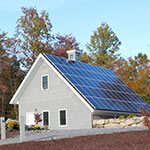Like many architects, Harold Turner became interested in sustainable design in the early 1980s after the energy crisis. In 2007, he took that interest a step further and began to look for a parcel of land that would allow him to build a prototype for what he considered a truly sustainable home.
His company, H.L. Turner Group, recently completed the Rose Cottage in Concord, New Hampshire, which is a testament to the idea that LEED certification, however admirable, isn’t the end-all-be-all of sustainable building. “The idea of going net zero five years ago was outrageous in most circles, but I personally thought it was the future of all things green,” Turner says.
The 4,100-square-foot residence sits on a nearly nine-acre lot along the shoreline of Turtle Pond, but the site offered just more than two acres of buildable land (the rest consists of a conservation easement). In response, project architect David Hart situated the cottage on multiple levels of the natural sloping terrain with the main views facing northwest toward the pond.
Achieving net-zero energy is a long process that starts with energy reduction. “You first have to ask, ‘How little energy can I use?’” Turner says. “Then it becomes a question of how you generate what power you need with renewables.” Hart insulated the envelope of the home with R40 upper walls, R27 ICF lower walls, and R60 roofs, and he carefully selected doors and windows to reduce leakage and placed them to take advantage of natural lighting. Heating and cooling are provided by two Bosch ground-source heat pumps connected to a horizontal ground loop system. Together, these systems work to allow the residents of the cottage to create both warm and cool spaces.
Perhaps most notable is the home’s photovoltaic system by BP Solar. All of the electric power consumed in the house and for the outdoor spa is generated by the panels, which cover the south side of the detached carriage-style garage. Yet, the panels don’t dominate the home’s exterior. “One of the hardest things to do when using solar to generate power is making it look attractive,” Turner says. The team placed the nine Buderus Logasol SKS 4.0 panels, which, in conjunction with a Seisco on-demand water heater, provide hot water, on the roof of the home. The 60 photovoltaic panels, on the other hand, were mounted on the roof of the detached garage. “Because the panels are the same size as the roof, after a while they appear to be one and the same,” Turner says.
Equally important to the project’s green goals, the home has been designed around the concept of multigenerational living, making the house suited to the lifetime of the homeowner. Turner says the idea of “aging in place” is necessary as the marketplace demands more options for in-home care, whether provided by family members or hired caregivers. The home suits the needs of one family through multiple generations, with an upper level that can be used as a primary residence and a lower level that can be transformed into an in-law or caregiver suite. The house specifically accommodates wheelchairs, with 36-inch-wide doors (34 for pocket doors), and there is no step down from the interior space to the three-season room. Wheelchair ramps can be added later to transition the eight-inch differential height from the home’s interior to the exterior rear deck. “People who don’t have homes designed to accommodate the aging of the population have difficulties incorporating those changes later, so we wanted to address it as more than an afterthought,” Turner says.
Creating a net-zero home is always a challenging task, but the additional requirements of the “aging in place” concept made the project exceptionally difficult, Turner says. Still, Hart was able to complete the home at a construction cost of $175 per square foot, including all renewable technologies. In Turner’s words, “This project takes the long-term investment of a sustainable home and adds even more value by including a multigeneration-use layout and incorporating ‘aging in place’ features.”


